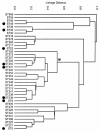Bacterial wall as target for attack: past, present, and future research
- PMID: 14557293
- PMCID: PMC207114
- DOI: 10.1128/CMR.16.4.673-687.2003
Bacterial wall as target for attack: past, present, and future research
Abstract
When Bacteria, Archaea, and Eucarya separated from each other, a great deal of evolution had taken place. Only then did extensive diversity arise. The bacteria split off with the new property that they had a sacculus that protected them from their own turgor pressure. The saccular wall of murein (or peptidoglycan) was an effective solution to the osmotic pressure problem, but it then was a target for other life-forms, which created lysoymes and beta-lactams. The beta-lactams, with their four-member strained rings, are effective agents in nature and became the first antibiotic in human medicine. But that is by no means the end of the story. Over evolutionary time, bacteria challenged by beta-lactams evolved countermeasures such as beta-lactamases, and the producing organisms evolved variant beta-lactams. The biology of both classes became evident as the pharmaceutical industry isolated, modified, and produced new chemotherapeutic agents and as the properties of beta-lactams and beta-lactamases were examined by molecular techniques. This review attempts to fit the wall biology of current microbes and their clinical context into the way organisms developed on this planet as well as the changes arising since the work done by Fleming. It also outlines the scientific advances in our understanding of this broad area of biology.
Figures








References
-
- Abramson, E. P., and E. Chain. 1940. An enzyme from bacteria able to destroy penicillin. Nature 146:837. - PubMed
-
- Barlow, M., and B. G. Hall. 2002. Phylogenetic analysis shows that OXA β-lactamase genes have been on plasmids for millions of years. J. Mol. Evol. 55:314-321. - PubMed
-
- Brown, J. T. R., C. J. Douady, M. J. Italia, W. E. Marshall, and M. J. Stanhope. 2001. Universal trees based on large combined protein sequence data sets. Nat. Genet. 28:281-285. - PubMed
-
- Bush, K. 1999. β-Lactamases of increasing clinical importance. Curr. Pharm. Design 5:839-845. - PubMed
-
- Bush, K. 2001. New beta-lactamases in gram-negative bacteria: diversity and impact on the selection of antimicrobial therapy. Clin. Infect. Dis. 32:1085-1089. - PubMed
Publication types
MeSH terms
Substances
LinkOut - more resources
Full Text Sources
Other Literature Sources
Medical
Miscellaneous

